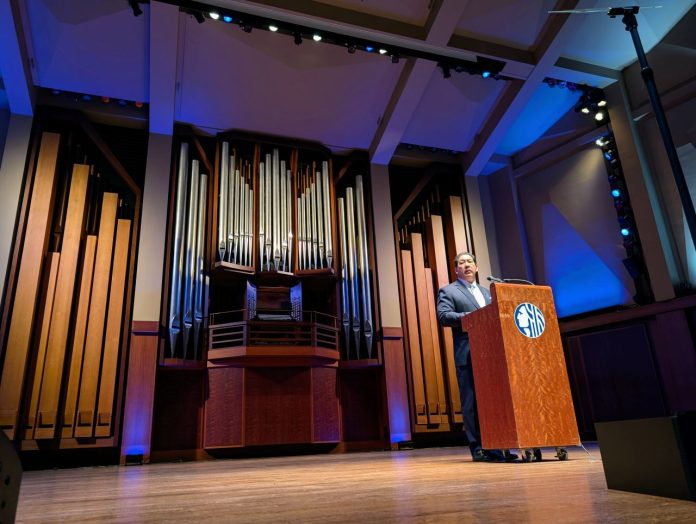
Seattle Mayor Bruce Harrell teased a few urbanist-minded initiatives as he delivered his annual state of the city speech on Tuesday. The mayor put his support behind a push to pedestrianize Pike Place Market and launched a new “Northern Lights” vision to redesign Aurora Avenue N and revitalize surrounding blocks in North Seattle — though exactly when either change would occur remains unclear.
“Now I have a vision for connected waterfront and Pike Place Market is one of the greatest pedestrian experiences in the country, where market patrons, visitors from out of town and downtown residents do not have to worry about vehicle traffic,” Harrell said Tuesday. “It’s one thing to work your way through crowds and enthusiastic shoppers trying to get that nice juicy salmon. It’s another thing to weave through stop-and-go automobiles.”
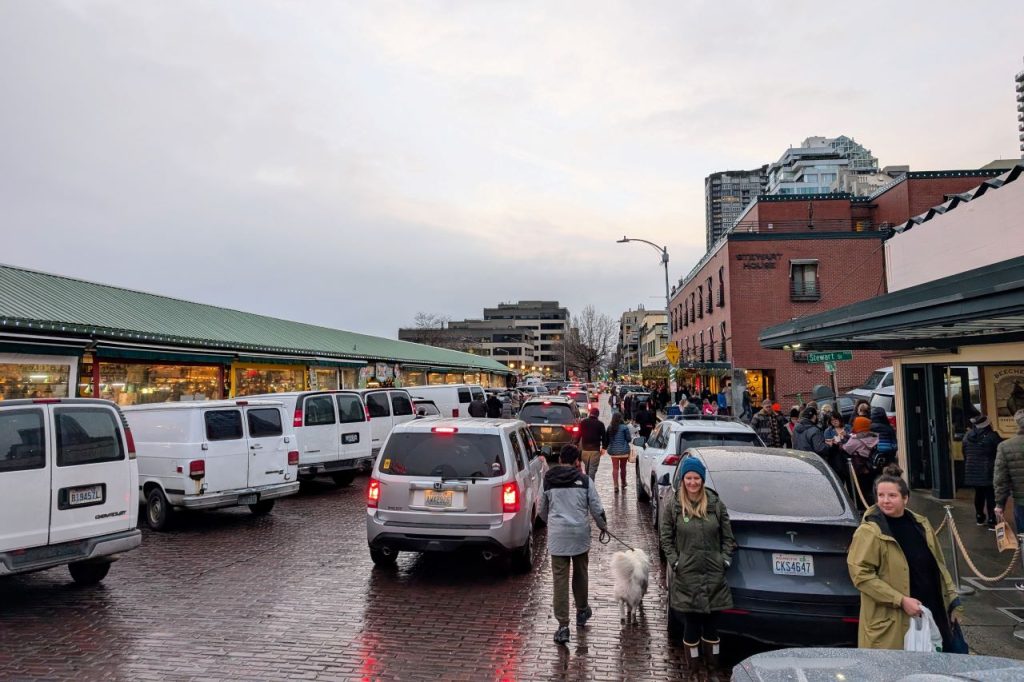
Harrell ramped up his rhetoric against Trump and the lawbreaking and overreach his administration has been carrying out, which was a shift in tone from his earlier talks of collaboration with Trump. (See our Wednesday story for more on that.)
The mayor also underscored his ongoing quest to lure the NBA to Seattle and bring back the Sonics, faking out attendees when he pulled out a basketball from behind the lectern and said he had a big announcement, earning both laughs and groans as he pivoted to Memorial Stadium renovation update rather than an NBA announcement. Unlike other initiatives Harrell mentioned in his speech, the Memorial Stadium revamp is being led by private partners, through the One Roof Stadium Partnership.
I hope the mayor was serious about the Aurora and Pike Place stuff.
— Qagggy! (@qagggy.bsky.social) February 19, 2025 at 3:48 PM
[image or embed]
The newly unfurled initiatives could point to a mayor looking to broaden his coalition heading into a reelection fight that is perhaps starting to look a little tougher than initially predicted. The 26-point victory that the social housing measure Proposition 1A won this month has led to rumors in progressive circles of bigger names stepping into the race to challenge the mayor. Harrell endorsed the Council-backed alternative and appeared on campaign mailers that sought to block the grassroots measure, but couldn’t move the needle.
Harrell argued Seattle is making strides to decrease crime, noting a drop in crime rates. He also said initiatives in Little Saigon, a hot spot for drug dealing and crime, are starting to bear fruit and "shift norms."
— The Urbanist (@theurbanist.org) February 18, 2025 at 12:40 PM
The Mayor also faces arguably the first major scandal of his term as news broke that Harrell was arrested in Iowa on gun charges in 1996. The incident stemmed from a parking dispute outside a casino that escalated in the future mayor brandishing a pistol for which he did not have a conceal and carry permit, which was required at the time. This news had remained buried on the West Coast until an anonymous tipster passed the lead to KUOW, which was able to corroborate and publish the story.
The mayor has blamed the arrest on racial profiling and youthful exuberance on his part, though he was 37 years old at the time.
Seattle Greenways pushes summer rollout for Pike Place
Seattle Neighborhood Greenways has been pushing the city to pedestrianize streets that attract a lot of foot traffic like Pike Place for years, and launched a campaign called “Pedestrian This” in 2023. The group’s executive director Gordon Padelford commended the mayor for getting behind the Pike Place idea.
“Thank you, Mayor Harrell, for your leadership in prioritizing people over cars at Pike Place Market,” Padelford said in a statement. “Markets around the world have successfully restricted vehicles while maintaining essential access for vendors, delveries, and people with disabilities. Seattle can—and should—do the same. And it would be popular too: 80% of Seattle voters support pedestrianization in scientific polling.”
Harrell also pledged his plan would account for deliveries and access for people with disabilities.
“So achieving this goal will require ingenuity and frankly commonsense,” Harrell said in his speech. “So as we make consideration for merchants, deliveries, and ADA access, all of this will be put together in what we will propose.
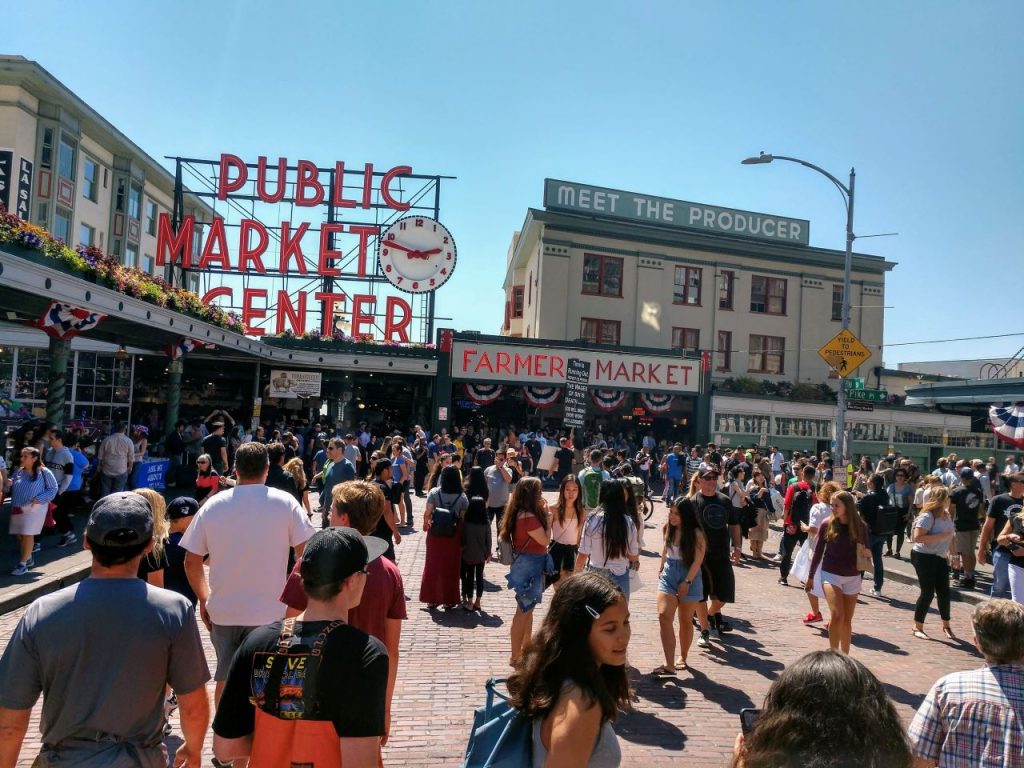
Councilmember Bob Kettle, whose District 7 includes Pike Place Market, has been much more hesitant to back pedestrianization, and cited a need to defer to the Market’s multi-layered oversight boards, which have resisted changes. Even a dangerous road rage incident in April 2022 was not enough to break the impasse around altering the street to improve safety and the pedestrian experience. However, the recent tragic vehicular attack on New Orleans’ pedestrianized Bourbon Street seems to have shifted the mayor’s thinking. Kettle has promised a community discussion between Market figures and advocates later this spring.
“Now, unfortunately, we also have to look at this through another lens, and that will be the lens of the horrific and horrible vehicle attack in New Orleans,” Harrell said. “Now I’m committed to bringing together our city departments, our market leadership and other stakeholders to make sure this vision becomes a reality.”
But pedestrian advocates’ patience for endless Seattle process is growing thin.
“Seattleites are tired of endless talk about this topic and want to see action,” Padelford said. “Seattle Neighborhood Greenways is eager to work with city government and market stakeholders to find win-win solutions that can be tried this summer.”
The group is hoping that a phalanx of support for pedestrianization could make that goal of testing solutions this summer feasible.
“Mayor Harrell has committed to working with City departments, market leadership, and other stakeholders to implement this vision. Seattle Neighborhood Greenways urges the city to select solutions that can be tested, measured, and improved — starting this summer,” the group added in a press release. “Community members can show their support by contacting the Seattle City Council and urging them to move forward with plans to prioritize people at Pike Place Market. They can do so easily by using an Action Alert created by Seattle Neighborhood Greenways. To access it, visit seattlegreenways.org/pikeplace.”
Aurora Avenue: Northern Lights or flickering mirage?
The mayor’s backing of Aurora Avenue overhaul may be farther from delivering tangible changes.
“So later this year, we will announce the Northern Lights project, an effort to redefine this area and optimize great already existing assets: bus rapid transit, parks like the Bitter Lake Playfield, and fantastic restaurants and small businesses,” Harrell said. “We will be seeking input from the community on what they would like to see.”
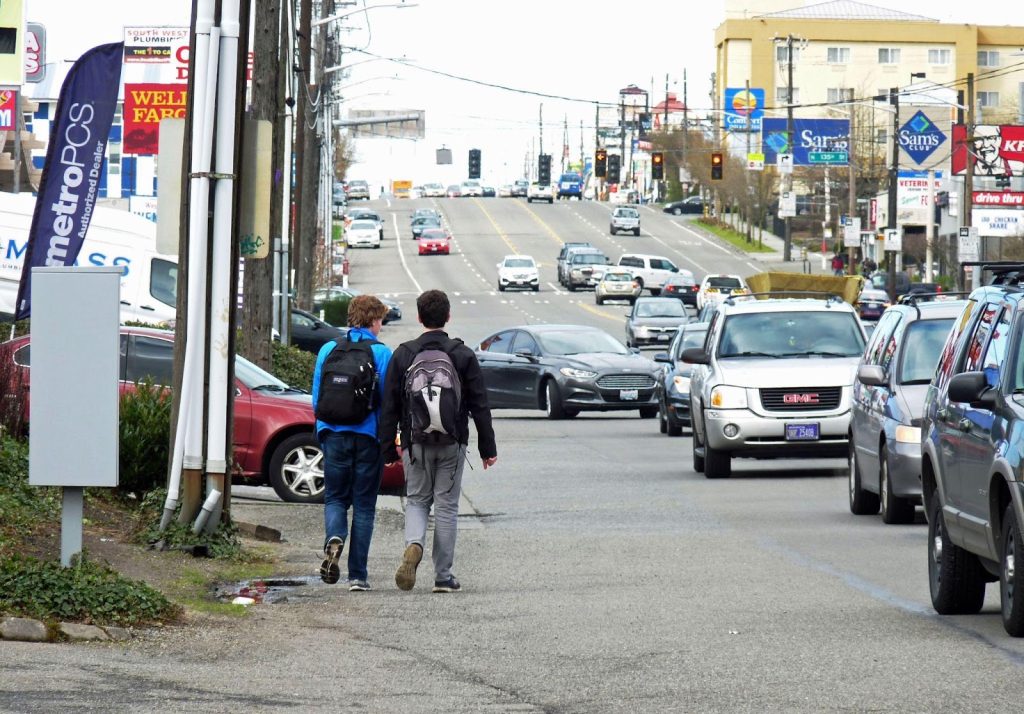
The Aurora Reimagined Coalition (ARC) has been pushing the city to overhaul the street to overhaul outcomes, but the City’s process has been fairly slow-moving thus far, leading state leaders to delay $50 million worth of pledged state matching funds for the overhaul work. Carlo Alcantara, an ARC leader, shared both excitement and surprise at the news.
“The announcement of the Northern Lights plan took us by surprise, and it is encouraging to see that [Harrell] has taken an interest in the north Aurora corridor,” Alcantara said. “ARC has been advocating to reimagine Aurora since 2021, and we communicate regularly with city and state stakeholders on behalf of the community. We’d certainly like to see the mayor take a holistic approach to the corridor and surrounding neighborhoods with the same level of care and attention his administration has given to ‘activate’ the downtown area.”
Alcantara was also a fan of the Pike Place pedestrianization and hoped to see effective stakeholder engagement on both projects. “As a Seattle resident, I am personally excited by the mayor’s announcement to make Pike Place more walkable by bringing together City departments, Market leadership, and other stakeholders,'” he said. “And I am eager to see this kind of approach taken by him to redefine and reimagine the north Aurora corridor.”
ARC has advocated for a road diet on Aurora, which is a sticking point for freight interests, which have become increasingly entrenched in blocking bus and safety project on freight corridors citywide.
“We envision an Aurora that puts people first by designing the street for people walking, biking, and riding transit,” the group states on their website, also noting they’d like to mitigate the urban heat island effect, which would mean more trees along Aurora. Aurora Reimagined has shared renderings (including in an Urbanist op-ed) that make it clear that rededicating a lane in each direction of the seven-lane road toward spaces for pedestrians and trees is part of their vision.
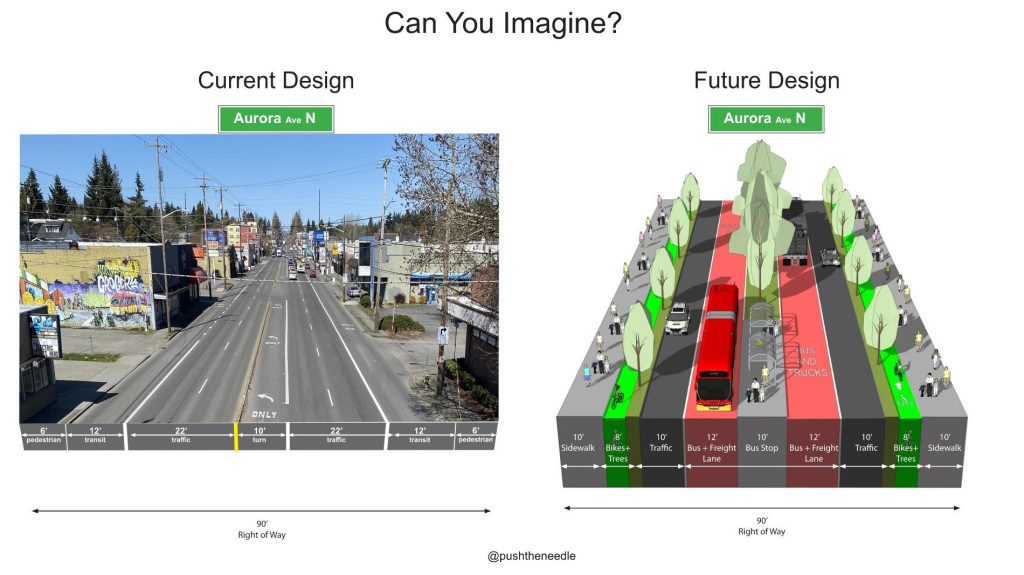
It appears the mayor’s vision may focus on greater density and cracking down on crime and shunting sex work elsewhere, with no specific changes to the road design mentioned in his speech.
“But for Seattle to continue to rise, our neighborhoods cannot stay stagnant. That’s why we must envision a new kind of neighborhood along Aurora Avenue as an example,” Harrell said. “Despite caring and involved neighborhoods, our adopted vision of Aurora has consistent with strip malls, car dealerships, and illicit activities. The community deserves a neighborhood that inspires them, with a built environment and energy to match.”
It remains to be seen if rededicating space away from cars will become is part of the mayor’s vision. As it stands, the Harrell Administration has backed extending the road’s patchy hodgepodge of bus lanes during “Revive I-5” construction work. However, the Washington State Department of Transportation delayed that freeway maintenance work due to budget issues and a looming larger financial reckoning for the state’s megaproject plans. And mayor stopped short of pledging extended Aurora bus lanes would remain after I-5 work concluded.
One member of the Aurora Reimagined Coalition’s steering committee, Mark Ostrow, applauded the mayor for queuing up an Aurora overhaul, while noting the project would take years to come to fruition.
“Currently, Aurora does serious harm to the people living there,” Ostrow wrote in a statement shared online. “They endure noise pollution, air pollution and a degradation of civic life, all for the convenience of people just passing through. Highways have a role connecting cities but they have no place in a dense urban environment. Fortunately, the state legislature, the mayor, and numerous civic organizations seem to recognize this fact and are working to fix it. This project will take years but we are in it for the long haul.”
However, Erica C. Barnett of PubliCola chided the mayor’s plan, insinuating it amounted to gentrifying North Seattle along the lines of South Lake Union (SLU) — a former warehouse district turned glitzy tech hub — and pushing auto-oriented small businesses out of the city.
“Counterpoint: Every city needs an area with strip malls and car lots — not every area of a city needs to be SLU-ified!” Erica Barnett wrote in a BlueSky post, later adding in a thread with a proponent: “And your point is… there shouldn’t be junk yards? Or used tire stores? Or non-corporate auto mechanics? Like you just think all these businesses are bad and should be shunted to other, less prosperous cities?”
Ryan DiRaimo, an architect and advocate for redesigning Aurora and increasing housing opportunities in his neighborhood of Aurora-Licton Springs and citywide also critiqued the plan from a different angle: not emphasizing road safety enough. DiRaimo has contributed a number of guest pieces to The Urbanist, including several about Aurora, such as 2018 proposal for a walkability-focused redesign and a 2022 proposal imagining elevated rail on Aurora.
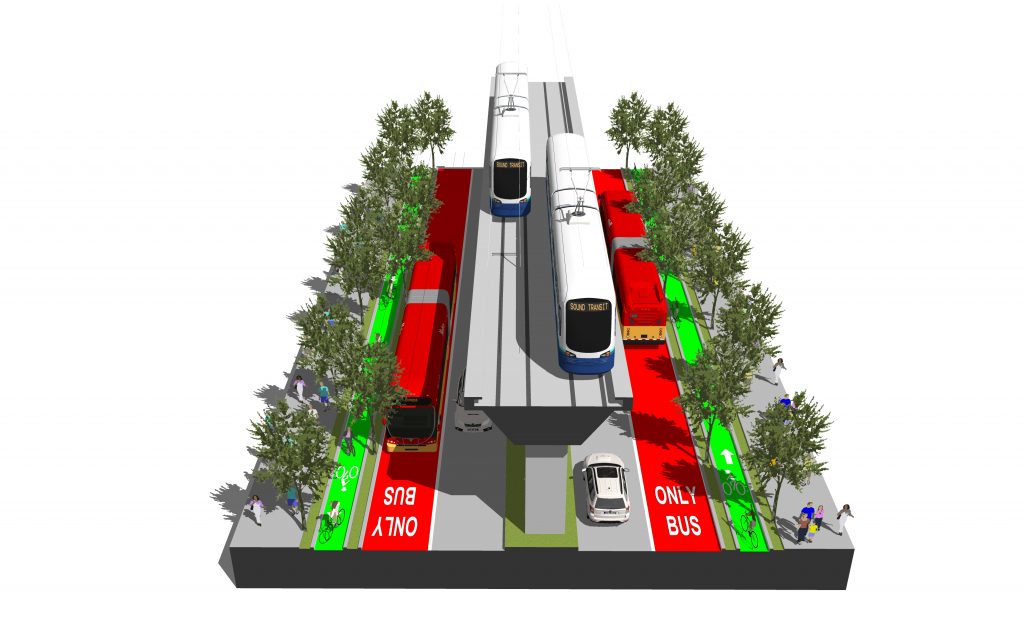
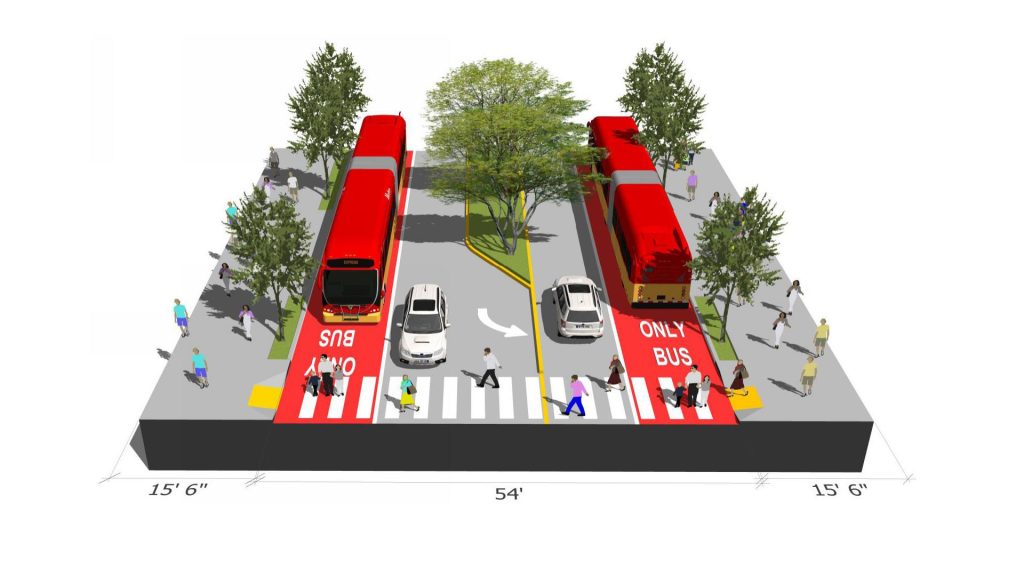
“The State of the City Address was the first I’d heard of this project (Northern Lights?),” DiRaimo said in an email. “Speaking for myself as a long-time Aurora activist and resident, I think density on arterials like Aurora only makes sense if Aurora is redesigned to be livable, servicing transit, biking and walking safely and reducing the car traffic on the road.”
On the other hand, DiRaimo did think the mayor was right to want to re-envision Aurora.
“I think Aurora has a lot of opportunities and I don’t subscribe to Erica Barnett’s statements online that every city needs a crappy area like Aurora,” DiRaimo added.
Social housing gets no mention
Meanwhile, one thing that didn’t get mentioned in the mayor’s speech: social housing. Funding the Seattle Social Housing Developer was just the topic of a special election earlier this month. With Harrell’s backing, the Seattle City Council put forward an alternative measure crafted by the Seattle Metropolitan Chamber of Commerce seeking to throttle funding for social housing. Nonetheless, the grassroots measure that will tax Seattle’s wealthiest companies on top salaries in order to create a dedicated funding source for social housing prevailed.
Doug Trumm is publisher of The Urbanist. An Urbanist writer since 2015, he dreams of pedestrian streets, bus lanes, and a mass-timber building spree to end our housing crisis. He graduated from the Evans School of Public Policy and Governance at the University of Washington in 2019. He lives in Seattle's Fremont neighborhood and loves to explore the city by foot and by bike.


